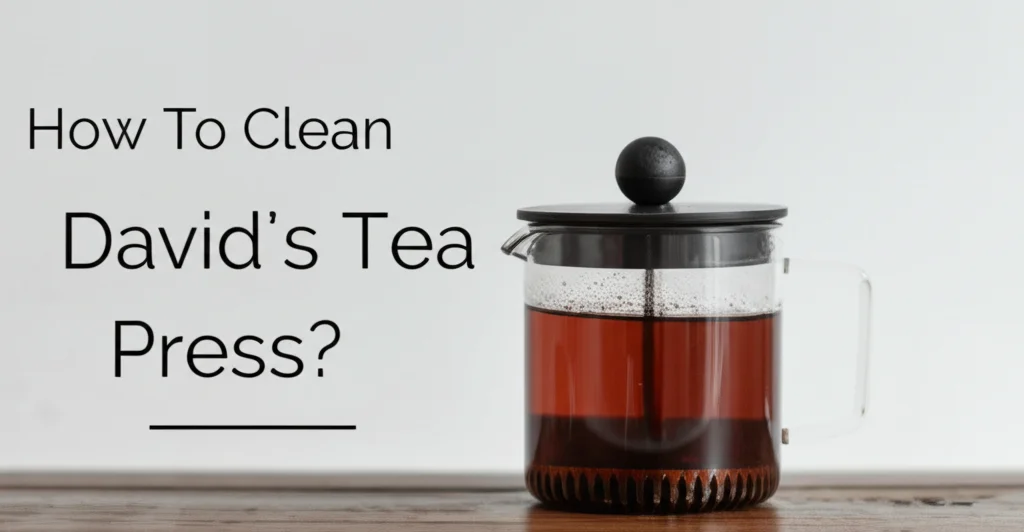· Kitchen Cleaning · 6 min read
How To Clean David's Tea Press?

How To Clean Your David’s Tea Press: A Simple Guide
Do you love the convenience and flavor of brewing tea with a David’s Tea press? A clean tea press is essential for enjoying the best possible taste and preventing buildup that can affect your tea’s quality. This article will walk you through everything you need to know about cleaning your David’s Tea press, from daily rinses to deep cleaning routines. We’ll cover the best methods, tools, and preventative measures to keep your press in top condition. Let’s get started and ensure your next cup of tea is as delightful as the first!
Takeaway:
- Rinse your David’s Tea press after each use.
- Disassemble the press for a thorough cleaning weekly.
- Use mild dish soap and warm water for most cleaning tasks.
- Descale your press monthly to remove mineral buildup.
Quick Answer:
To clean a David’s Tea press, disassemble it, wash each part with warm, soapy water, rinse thoroughly, and allow to air dry. For stubborn residue, soak parts in a baking soda and water solution. Regular cleaning prevents buildup and ensures optimal tea flavor.
Why Cleaning Your David’s Tea Press Matters
Cleaning your David’s Tea press isn’t just about aesthetics; it directly impacts the taste of your tea. Over time, tea leaves and oils can accumulate inside the press, leading to stale flavors and potential mold growth. A buildup of tea residue can also clog the filter, making it harder to press and resulting in a weaker brew. Regular cleaning ensures a consistently delicious and hygienic tea-making experience. It also extends the life of your press, protecting your investment.
Daily Maintenance: The Quick Rinse
After each use, a quick rinse is your best friend. This simple step prevents tea leaves from drying and sticking to the press’s components. Immediately after brewing, empty the used tea leaves. Then, rinse the press, plunger, and filter with warm water. This removes loose particles and prevents staining. Don’t worry about a deep clean every time; this daily rinse is enough to keep things manageable.
Weekly Deep Clean: Disassembly and Washing
A weekly deep clean is crucial for removing stubborn residue and maintaining optimal hygiene. Start by completely disassembling your David’s Tea press. This usually involves removing the plunger, filter, and any other detachable parts. Wash each component with warm water and a mild dish soap. A soft sponge or cloth is ideal to avoid scratching the surfaces. Pay close attention to the filter, ensuring all tea particles are removed.
Cleaning the Filter: A Key Component
The filter is the heart of your David’s Tea press, and it requires special attention. Tea leaves can easily get lodged in the fine mesh, hindering its performance. After removing the filter from the press, use a soft brush, like an old toothbrush, to gently scrub away any remaining tea particles. You can also soak the filter in warm, soapy water for a few minutes to loosen stubborn residue. Rinse thoroughly under running water before reassembling.
Monthly Descaling: Removing Mineral Buildup
If you live in an area with hard water, mineral buildup can accumulate inside your David’s Tea press over time. This buildup can affect the taste of your tea and reduce the press’s efficiency. To descale your press, fill it with a solution of equal parts white vinegar and water. Let the solution sit for at least 30 minutes, or even overnight for heavy buildup. After soaking, rinse the press thoroughly with water until the vinegar smell is gone. You can find more information on descaling appliances at https://www.beacleaner.com/how-to-clean-kitchen-mats/.
Tackling Stubborn Stains and Residue
Sometimes, despite your best efforts, stubborn stains or residue may linger. For these situations, a baking soda paste can be a lifesaver. Mix baking soda with a small amount of water to create a paste. Apply the paste to the stained areas and let it sit for 15-20 minutes. Gently scrub with a soft cloth or sponge, then rinse thoroughly. Baking soda is a natural abrasive that can effectively remove stains without damaging the press. If you’re dealing with tough stains elsewhere, you might find this article helpful: https://www.beacleaner.com/how-to-remove-sticky-residue-from-vinyl-flooring/.
Materials to Avoid When Cleaning
Certain materials can damage your David’s Tea press. Avoid using abrasive cleaners, such as scouring powders or steel wool, as they can scratch the surfaces. Harsh chemicals, like bleach, can also be harmful and may leave behind unpleasant odors. Similarly, avoid putting your press in the dishwasher unless the manufacturer specifically states it is dishwasher-safe. Handwashing is generally the safest and most effective method.
Drying and Storage: Preventing Mold Growth
Proper drying and storage are essential for preventing mold growth. After cleaning, allow all components of the press to air dry completely before reassembling. Ensure there is no trapped moisture, as this can create a breeding ground for mold. Store your press in a cool, dry place, away from direct sunlight. If you live in a humid environment, consider storing the press with the lid slightly ajar to allow for ventilation.
FAQ: Common Questions About Cleaning Your David’s Tea Press
Q: Can I use hot water to clean my David’s Tea press?
A: While warm water is ideal, avoid using boiling water, as it could potentially damage the plastic or glass components of the press. Warm water is sufficient for removing tea residue and sanitizing the press.
Q: How often should I replace the filter?
A: The filter should be replaced every 6-12 months, depending on usage. If you notice the filter becoming clogged or damaged, it’s time for a replacement.
Q: My David’s Tea press has a lingering tea smell. How can I get rid of it?
A: Soaking the press in a solution of baking soda and water can help neutralize odors. Rinse thoroughly after soaking. You can also try using a small amount of lemon juice in the cleaning solution.
Q: Is it safe to clean the glass beaker with a glass cleaner?
A: While glass cleaner can be used on the beaker, ensure it’s a non-abrasive formula and rinse thoroughly to remove any residue before brewing your next cup of tea.
Conclusion: Enjoying a Clean and Flavorful Brew
Keeping your David’s Tea press clean is a simple yet vital part of enjoying a consistently delicious cup of tea. By following these guidelines – from daily rinses to monthly descaling – you can prevent buildup, maintain optimal hygiene, and extend the life of your press. Remember, a clean press means a better-tasting brew! Don’t let residue ruin your tea experience; take a few minutes each week to give your press the care it deserves. For more cleaning tips around the house, check out our guide on https://www.beacleaner.com/how-to-clean-kitchen-sink-mats/. Now, go enjoy a perfectly brewed cup of tea!




